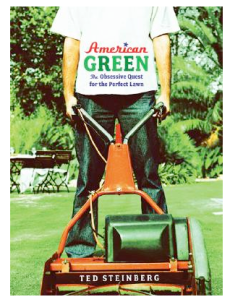
American Green - easy funny read, will make you reconsider your lawn size and habits
Winter is the time when we have chance to breathe and read (spring thru late summer is our busiest season). So what am I reading…a book on lawns (you would think I could branch out beyond lawn mowers a bit right! 🙂 ). Specifically American Green: The Obsessive Quest for the Perfect Lawn by Ted Steinberg….which is an easy and funny read…even if you aren’t in a garden-related business.
Steinberg looks at both the lighter and the darker side of the all-American landscape, from mower accidents and pesticide poisonings to lawnmower racing and the man so addicted to perfection that he re-created Augusta’s 12th hole in his backyard. For Steinberg, the Scotts Company, the top seller of grass seed and fertilizer, is the ultimate villain, with its lawn propaganda that has convinced Americans to undertake time-consuming yard work that is nothing short of a “perpetual cycle of creative destruction.”
SEX, FOREIGN AID, AND AMPUTATIONS VERSES LAWN CARE (or you may not realize how much time and money our culture spends on lawns)
So Steinberg wants you to know :
- TIME: The average homeowner will spend 150 hours a year maintaining their lawn (… but only 35 on sex!)
- PESTICIDES: 10 times more herbicides per acre are dumped on lawns than on the fields of agribusiness.
- MONEY: Per acre, it costs more to maintain a lawn than it does to grow corn, rice or sugarcane. More than 40 billion dollars are spent on the lawn in North American each year – more than the entire continent gave in foreign aid in 2005.
- BIRDS + BEES: In the U.S. an estimated 7 million birds are killed yearly by lawn-care pesticides. Honey Bee Colony collapse disorder is being linked to pesticides.
- RUNOFF + FISH: Phosphorus run-off from lawn fertilizer causes algae blooms that suck oxygen out of lakes, asphyxiating fish.
- WATER: 30% of the water used on the East Coast of U.S. goes towards watering of lawns. A single golf course in Tampa, Florida uses 178,800 gallons of water every day, enough to meet the daily water needs of over 2,200 people.
- SAFETY: Approximately 7,500 Americans are injured every year using lawn mowers, about the same number as firearms. About 10,000 of those accidents involve children. More than 30% these injuries resulted in an amputation of some sort. That’s more than 22,000 limbs and digits that go missing every year in pursuit of the perfect green!
OK, so reading this book (or skimming this article) you are now empowered to ignore those advertisements to “show your lawn who is boss”, give up your unobtainable perfect lawn image, and create some biodiversity and pleasure in garden! Lastly, remember, noone can nap in their hammock if you using nasty smelly noisy lawn or garden equipment – read my rant on noise pollution in the garden and how it is affecting our health.
—————-
ABOUT US
For 11 years family owned peoplepoweredmachines has been active in the “less lawn, less emmissions”, organic lawn care and switch from gas mower to reel mower movement….way before it was so popular! We carry a line of enviromentally sound products that we carefully test and stand behind. We enjoy sponsoring teens with special terms to buy reel mowers (safer and greener) for their summer mowing business.
Enjoy your yard! David

Pingback: Earthday 2009: Our Top Ten Must-Read Articles « People Powered Machines
Pingback: New Brill Reel Lawn Mowers for 2009 « People Powered Machines
Pingback: America Spends More Money on Lawn Care than Foreign Aid Why We | Hammock Stand
Pingback: It takes 35 gallons to make a cup of coffee, 100 to make a t-shirt… « People Powered Machines
Pingback: How to Transition your Lawn from a Rotary Mower to a Reel Mower « People Powered Machines
This is a great post with good information. It’s a topic that should be brought up more. What drives this obsession Americans have with lawns? Is it just marketing or some need to control things?